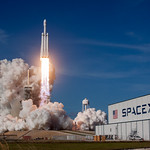Success Stories
CFD Simulations for SPACEX to ensure Successful Space Vehicle Launches (2019)
 The Air Force Research Laboratory (AFRL) DoD Supercomputing Resource Center (DSRC) has been allocating SpaceX Core hours on Lightning, Thunder and Mustang since 2016. Allowing SpaceX to use the DoD supercomputers has enabled their researchers to perform Computational Fluid Dynamic (CFD) simulations prior to the launches of Falcon 9 and Falcon Heavy. These simulations are critical to the success of the launches, thereby further enhancing DoD and Air Force missions. Performing the desired calculations would have been prohibitively time consuming using SpaceX’s internal computing resources, therefore the use of the Lightning, Thunder and Mustang were of paramount importance.
The Air Force Research Laboratory (AFRL) DoD Supercomputing Resource Center (DSRC) has been allocating SpaceX Core hours on Lightning, Thunder and Mustang since 2016. Allowing SpaceX to use the DoD supercomputers has enabled their researchers to perform Computational Fluid Dynamic (CFD) simulations prior to the launches of Falcon 9 and Falcon Heavy. These simulations are critical to the success of the launches, thereby further enhancing DoD and Air Force missions. Performing the desired calculations would have been prohibitively time consuming using SpaceX’s internal computing resources, therefore the use of the Lightning, Thunder and Mustang were of paramount importance.
SpaceX specifically used High Performance Computing (HPC) to investigate flow phenomena and supplement its knowledge of the aerodynamics of space launch vehicles and associated hardware. CFD simulations were used on launch vehicle configurations at various conditions and vehicle orientations. Data output from these simulations were very impactful to: integrated aerodynamic coefficient databases, aerodynamic and aerothermal loads analyses, wind tunnel test data correlation, localized flow investigation, and miscellaneous investigations of flow phenomena.
 The recent DoD Space Test Program-2 (STP-2) launch of Falcon Heavy was a resounding success for both SpaceX and the Air Force. This mission delivered 24 satellites to space on the DoD's first ever SpaceX Falcon Heavy launch vehicle. The STP-2 mission was amongst the most challenging launches in SpaceX history with four separate upper-stage engine burns, three separate deployment orbits, a final propulsive passivation maneuver and a total mission duration of over six hours. In addition, the U.S. Air Force will reuse side boosters from the Falcon Heavy launch, recovered after a return to launch site landing, making it the first reused Falcon Heavy ever flown for the U.S. Air Force.
The recent DoD Space Test Program-2 (STP-2) launch of Falcon Heavy was a resounding success for both SpaceX and the Air Force. This mission delivered 24 satellites to space on the DoD's first ever SpaceX Falcon Heavy launch vehicle. The STP-2 mission was amongst the most challenging launches in SpaceX history with four separate upper-stage engine burns, three separate deployment orbits, a final propulsive passivation maneuver and a total mission duration of over six hours. In addition, the U.S. Air Force will reuse side boosters from the Falcon Heavy launch, recovered after a return to launch site landing, making it the first reused Falcon Heavy ever flown for the U.S. Air Force.
In support of the mission, in 2019 the DoD High Performance Computing Modernization Program (HPCMP) allocated 17 million core hours enabling SpaceX to perform aerodynamic analyses to further enhance mission success. HPC enabled additional databases to be developed for the ascent vehicle configuration with detailed geometry that would have not been available otherwise. This generated information was comprised of guidance, navigation, and control integrated vehicle coefficient databases - to include heating distributions, pressure distributions and the necessary engine load data. Without the DSRC’s HPC resources, the time it would have taken to create the needed data would have placed the launch vehicle production way behind schedule. Ultimately, HPCMP resources allowed SpaceX to experience quicker, safer and more reliable vehicle launches.
"The DoD, Air Force and SpaceX partnerships on the HPC systems will continue to be vital to our continued success of delivering the necessary aerodynamic analyses required for a reliable launch vehicle for the Air Force."
Benjamin Bettis, Manager, Aerodynamics Engineering, SpaceX


